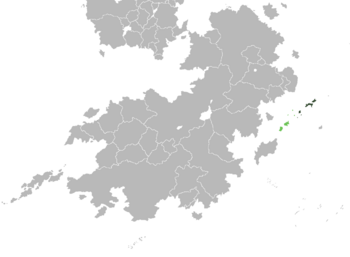North Kabu
This article is incomplete because it is pending further input from participants, or it is a work-in-progress by one author. Please comment on this article's talk page to share your input, comments and questions. Note: To contribute to this article, you may need to seek help from the author(s) of this page. |
Kabu Republic Republik Kabu (Kabu) | |
|---|---|
|
Flag | |
| Motto: Persatuan, Negara, Demokrasi, Kesejahteraan "Unity, State, Democracy, Welfare!" | |
 Land controlled by North Kabu shown in dark green, land claimed but not controlled shown in light green. | |
| Capital and largest city | Magelang |
| Official languages | Kabu |
| Recognised regional languages | Ilatbarat |
| Demonym(s) | Kabu Kabuese South Kabuese |
| Government | Unitary semi-presidential republic |
• President | Dian Suripto |
• Premier | Kumat Dumarwulan |
| Legislature | Senate |
| Establishment | |
• Colony of Kabu | 1797 |
• Start of Kabu Civil War | 1941 |
• Treaty of City | 1947 |
• Current Constitution | 1990 |
| Area | |
• Total | 39,482 km2 (15,244 sq mi) |
| Population | |
• 2020 census | 8,073,283 |
• Density | 202.63/km2 (524.8/sq mi) |
| GDP (PPP) | 2020 estimate |
• Total | $121.3 billion |
• Per capita | $15,023 |
| GDP (nominal) | 2020 estimate |
• Total | $46.3 billion |
• Per capita | $5,738 |
| Gini (2020) | 37.2 medium |
| HDI (2020) | 0.751 high |
| Currency | Kabu shilling (RKS) |
| Internet TLD | .rk |
North Kabu (Kabu: Kabupik Utara), officially the Kabu Republic (Kabu: Republik Kabu) is a state in Southeast Coius. While officially claiming the whole of the Kabu archipelago, its control is limited to the northeastern half of the archipelago and its claims of sovereignty over the southwestern portion of the archipelago are not universally recognised, with many recognising South Kabu, which the country shares a de facto maritime border with. The country's de facto territory consists of sixty-one islands, yet the vast majority of the population is concentrated on the three Telung Sadulur islands in the south or the Sedulur Loro pair in the north.
Sublustrian peoples first settled the island chain during the middle of the first millenium, with evidence of cities built up around paddy fields existing in Sedulur Loro from the 7th century CE. Through contact and trade with Dezevau and other nations in which it was practised, the now-dominant Badi faith arrived in the islands in the 9th century, with elemental cults appearing across the islands. Badi kingdoms and empires would emerge in later centuries, with many of them spanning the whole island chain at their peaks and becoming prosperous over the spice trade. This spice trade, however, would lead to the interest in the islands by the Estmerish !East India Company, which would attempt to establish control over the islands in the 17th and 18th centuries in order to monopolise the trade.
As the Company became increasingly dominant, Estmerish control was cemented and in 1797 the islands were made into the nationalised colony of the Carolinian Isles. Colonial rule would persist for the next thirteen decades with little interruption, until the Gaullican occupation during the Great War led to an upsurge in support for anti-colonial movements, which would increase further after the war when Estmerish promises on self-government were not fulfilled. However, after moves were made to establish an independent state, tensions between nationalists and socialists led to the outbreak of the Kabu Civil War in 1941, with the modern state of North Kabu coming into being in 1947 after the Treaty of City split the archipelago between the two groups. Since then, the country has gone through two periods of authoritarian rule from 1947-1965 and 1978-1990, yet since 1990 the country has democratised and liberalised.
North Kabu is considered to be an middle-income country with one of the fastest growing economies in Coius, with the country boasting a rapidly expanding tertiary sector. Since the transition to democracy, governments have made it a priority to achieve universal literacy and healthcare, with the government aiming to achieve a literacy rate of 98% and a healthcare coverage rate of 95% by 2025.
